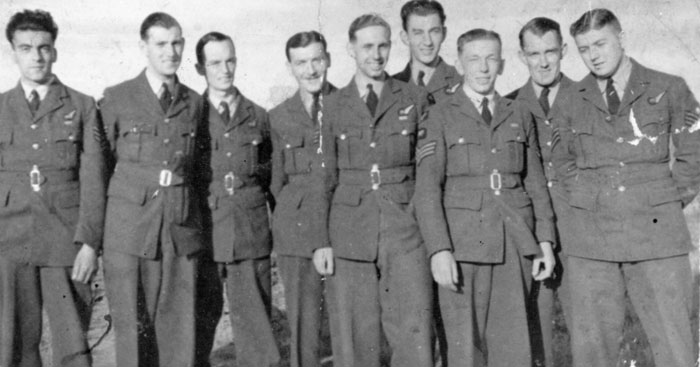The Airmen's Stories - Sgt. N H Guthrie
Norman Henry Guthrie was born on 10th September 1916 in Plumstead, London. He enlisted in 604 Squadron Auxiliary Air Force before the war as an air gunner and was called to full-time service on 24th August 1939.
He flew his first two operational sorties on 3rd August 1940 and the third on 11th August. Guthrie later retrained as a radar operator.

604 Squadron 1941.
L to R: AC1 B Cannon, Sgt. A Phillips, unknown, unknown, unknown, Sgt. NH Guthrie, Sgt. AA O'Leary, unknown, Sgt. DG Moody.
Above image courtesy of the Chris Goss Collection.
In December 1940 he teamed up with F/O ED Crew. On the night of 4th/5th April 1941 they destroyed a He111H-5 of III/KG26, which crashed at West Hewish, near
Weston-Super-Mare.
The aircraft was a Gruppe
pathfinder and three of its crew
survived to be interrogated about the tactics they employed.
On 8th December they damaged another, on the 24th destroyed a He111 and on the 28th another.
During the night of 8th May 1941 they damaged a He111 and on 7th July they destroyed a Ju88 and a He111 over Southampton.
Guthrie was awarded the DFM (gazetted 24th June 1941). He was posted away from 604 Squadron in July to 25 Squadron.
Guthrie was promoted to Warrant Officer on 1st March 1942.
On the night of 6th/7th September 1942 Beaufighter X7705 was aloft from Church Fenton with F/Lt. JL Shaw and Guthrie.
They were vectored onto a He111 by Patrington GCI. Interception was made 10-15 miles off Flamborough Head and hits were seen on the Heinkel. However return fire damaged the radio equipment and the hydraulics of the Beaufighter. On returning a belly landing was made but the aircraft was repairable.
Guthrie was commissioned on 8th September 1942.
On 15th November 1942 Shaw and Guthrie were aloft in Mosquito NFII DD755 for night practice interceptions under GCI Radcliffe. The AI failed completely and they made an early return.
Guthrie married Barbara Shipman in July 1943 in Hendon.
********************
His subsequent postings are currently undocumented until 1945 when he was serving with an all-volunteer unit, Combined Operations Pilotage Parties (COPP).
The unit had been formed in 1943 on Hayling Island, Hampshire. Its function was to train small teams of sailors and soldiers as frogmen and canoeists for covert beach reconnaissance and other essential clandestine operations prior to Allied landings on enemy occupied territory throughout the world.
By spring 1945, despite the fact that the Burmese capital Rangoon had not yet been captured, the Allies in the Far East were already planning the liberation of Singapore.
The first target in a stepping-stone sequence was the island of Phuket, Thailand.
In the event the assault was never carried out but the preparations, under the codename 'Operation Baboon ', began at the beginning of March 1945.
Guthrie was a member of COPP 3, one of a dozen or so groups.
On 3rd March 1945 COPP 3 left the navy base at Trincomalee in Ceylon (now Sri Lanka) on board the submarine HMS Torbay and spent the next three days in training.
On the night of 8th/9th March Torbay arrived off Phuket.
The original plan had been for seven men in three canoes to go ashore and remain for three days carrying out their surveys. But a periscope reconnaissance showed considerable enemy activity and it was decided to make nightly sorties and return to the submarine each morning.
For the first sortie personnel were split across three canoes:
Canoe 1 Hughes/Turner
Canoe 2 Alcock/Sowter
Canoe 3 Johns/Cammidge/Guthrie (in a three-man canoe).
The men in canoe 3 were specifically tasked with carrying out an airfield reconnaissance.
Torbay surfaced after dark, five nautical miles from the coast. After getting the canoes up onto the casing they ran in as close as the depth allowed.
Shortly after launching, canoe 3 disappeared from view. Canoes 1 and 2 successfully carried out their reconnaissance tasks.
Canoe 3 had not returned by first light and Torbay withdrew.
Torbay returned that night to the same drop-off position as the previous night. Suspiciously there was an absolute blackout on shore and no further sorties were made.
Torbay returned to the pick-up position on each of the following three nights but with no sign of the men ashore it was forced to abandon the vigil.
Despite calm conditions the heavily laden 3-man canoe had capsized on the approach, as the men waded ashore they came under fire from a Thai Navy patrol and Johns and Cammidge were killed. Guthrie managed to escape but was seen by natives the following day while passing through a village. The natives gave him food but, concerned about reprisals, called the Thai militia and he was taken prisoner.
The following day he was flown by the Thai Navy to Sutaheb, and then on 14th March was driven to the prisoner-of-war camp in Bangkok where he saw out the remainder of the war.
He had been interrogated by the Japanese and the Thais a total of seven times and from 15th June until 21st August 1945 he was a patient at Chulalongkorn Hospital suffering from anxiety neurosis.
Captain William Edward Field Johns of 2 Special Boat Section, Royal Engineers is buried at Kranji War Cemetery.
Sergeant Frederick Cammidge, Royal Engineers, is commemorated on the Rangoon Memorial.
********************
Guthrie was released from the RAF in 1946 as a Flight Lieutenant.
He settled in Ellaston, Staffordshire and took over the Bromley Arms there, later moving to the Duncombe Arms.

He died on 17th February 1981.
Additional research courtesy of Rob Crane at https://www.coppsurvey.uk/
|